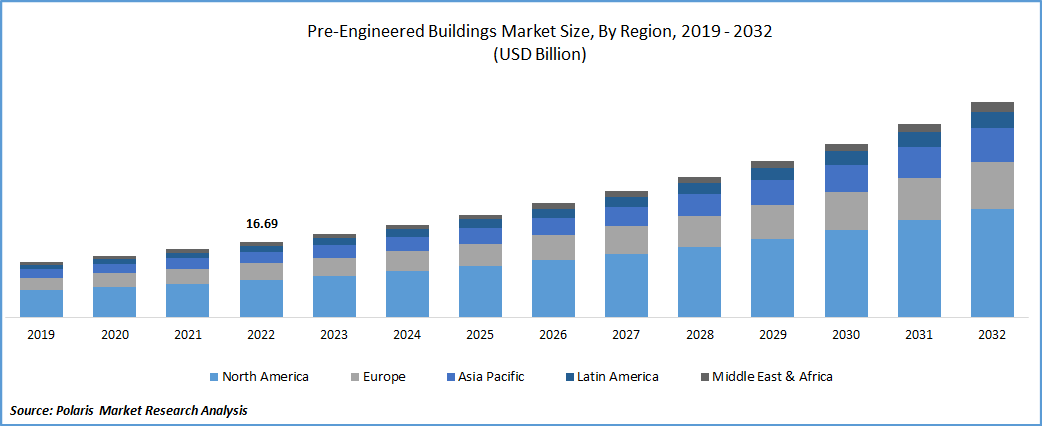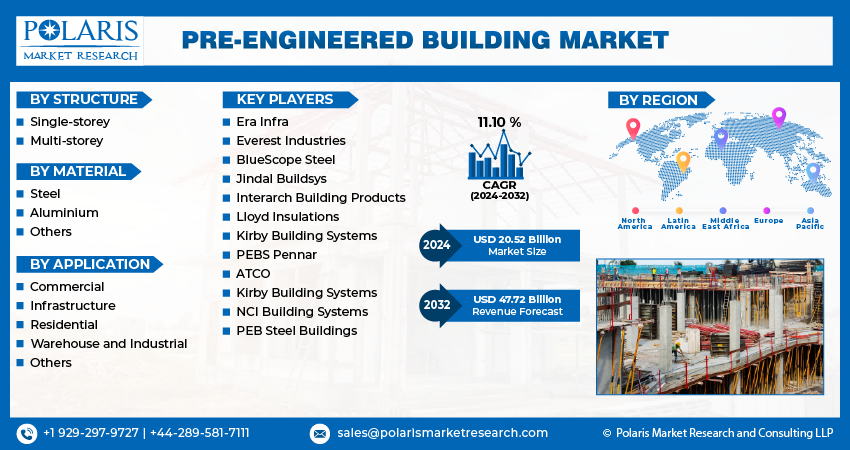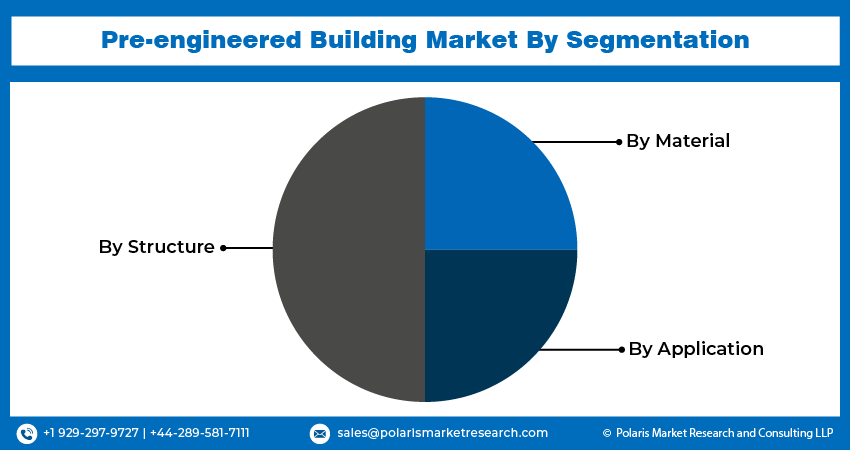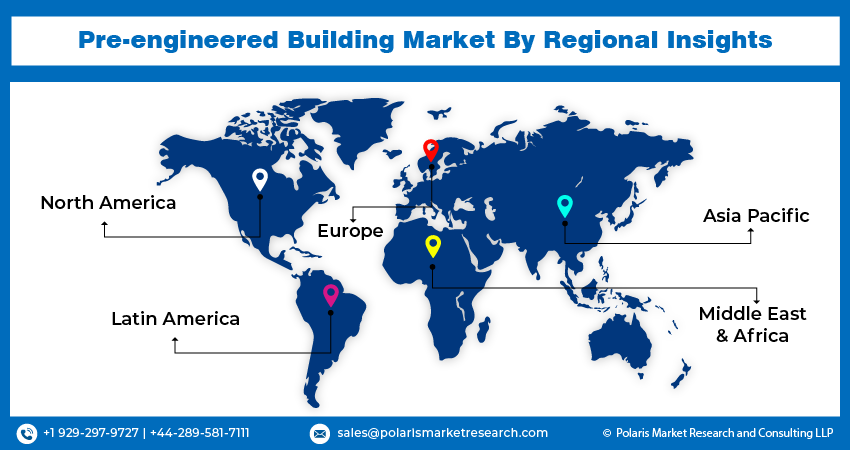
Pre-Engineered Buildings Market Share, Size, Trends, Industry Analysis Report, By Structure (Single Storey and Multi-Storey), By Material, By Application, By Region, Segments & Forecast, 2024 – 2032
- Published Date:Jan-2024
- Pages: 114
- Format: PDF
- Report ID: PM1625
- Base Year: 2023
- Historical Data: 2019-2021
Report Outlook
The global pre-engineered buildings market was valued at USD 18.51 billion in 2023 and is expected to grow at a CAGR of 11.10% in the forecast period. Rapid industrialization and urbanization in emerging economies demand building infrastructures in a less time and cost-effective way, which increases the adoption of pre-engineered building solutions. The market's growth has been further supported by the rising need for warehouses owing to the rising penetration of e-commerce and the growing trend towards green buildings and use of sustainable building materials.

Know more about this report: Request for sample pages
Pre-Engineered buildings (PEB) are metal enclosure structures made in a factory by a structural frame, standard roof, and wall support and are erected at the site. The complete designing of the building is done at the factory site, and the components are brought to the site in the knock-down condition. The concept drastically reduces construction time, increases cost-effectiveness, and maintains a high-quality infrastructure with less maintenance. Compared to traditional infrastructures, the pre-engineered building offers many advantages, including reduced project construction time by about 50%, low cost, and easily expanded. Better quality controls need lower maintenance, energy-efficient roofing and wall systems, and architectural versatility. Moreover, the Pre-engineered steel buildings can be fitted with various structural accessories such as mezzanine floors, interior partitions, canopies, and fascia and are made waterproof using special mastic beads, trims, and filler strips.
For instance, Amazon has constructed many fulfillment centers using pre-engineered steel building systems. These buildings are designed to maximize space and efficiency for the storage and distribution of products. Other key players in various sectors, including Tesla, Walmart, FedEx, and others have been leveraging the multiple benefits of new-age buildings. The Tesla Gigafactory in Nevada, which produces electric vehicle batteries and components, was constructed using pre-engineered building systems. The building has a footprint of 1.9 million square feet and is one of the largest pre-engineered buildings in the world.
The covid-19 pandemic hurts the pre-engineered building market owing to severe disruptions in manufacturing and supply chain operations due to precautionary lockdowns imposed by the government in various countries. Moreover, the market has been further hampered by the scarcity of migrant labor in construction sites and decreased demand for the real estate market among consumers during the pandemic.
The restraining factors for the market can be attributed to lower thermal conductivity, vulnerability to corrosion, and lack of fire resistance in pre-engineered buildings. Further, the market growth can be retarded by the fluctuating cost of raw materials and other demand-supply fluctuations constraints.

For Specific Research Requirements, Request for a Customized Report
Industry Dynamics
Growth Drivers
The higher utilization of pre-engineered buildings across various end-use applications owing to its multiple benefits has remained the most promising factor for pre-engineered buildings market growth in the forecast period. Generally, pre-engineered building systems find application in the construction of warehouses, industrial sheds, and buildings. While with the advancement of technology, the adoption rate for building systems has increased in various areas, such as pharmaceutical industries and others, in the last few years. Multiple applications include houses, living shelters, factories, sports halls, warehouses, supermarkets, aircraft hangers, office buildings, workshops, petrol pumps, community centers, railway stations, schools, and equipment housing/shelters.
The second most vital factor driving the pre-engineered buildings market is the huge need for warehouses by various e-retailers and other players. Rapid urbanization backed by better standard of living has increased the demand for different products in almost all regions.
In recent years, e-commerce has witnessed a significant revolution with better internet penetration and financial inclusion among the populations in developed and developing economies. For instance, as per U.S. Department of Commerce, the total estimate for U.S. retail e-commerce sales was about $ 1,034.1 billion in 2022, an increase of 7.7 percent from 2021. Increasing online trading of various commodities such as apparel, food and beverages, groceries, and others requires a proper warehouse to store the materials securely.
Report Segmentation
The market is primarily segmented based on structure, material, application, and region.
|
By Structure |
By Material |
By Application |
By Region |
|
|
|
|
Know more about this report: Request for sample pages
The Single-Story Segment Accounted for the Largest Market Share in 2022
Increasing non-residential infrastructure such as healthcare, recreational, educational, and retail has increased the demand for single-story pre-engineered buildings. Rising investments in infrastructural, industrial, and logistics constructions further drive the need. In addition, the lower price of single-story buildings and architectural flexibility support the segment over the forecast period.
While the multi-story segment is projected to witness the highest growth rate in the forecasted period, owing to the rise in the adoption of pre-engineered buildings for big retail outlets, offices, and other building projects.
The Steel Segment is Accounted to Witness the Fastest CAGR in the Forecasted Period
The major factors supporting the growth of the Steel segment can be poised to its many advantages over traditional construction methods, including cost savings, quick construction time, durability, and versatility. Using pre-engineered building components can result in cost savings for the customer compared to traditional construction methods. The pieces are manufactured in a controlled environment, which reduces waste and labor costs. In addition, it can be used for various purposes, including warehouses, manufacturing facilities, offices, and retail spaces, making it a favorable material for building use.
The Warehouses and Industrial Segment is Anticipated Witness the Highest CAGR in the Forecast Period
The strong consumer demand for various products has increased the growth of manufacturing, e-commerce, and logistics sectors over the last few years. The expansion further caters to the need for factories, R&D centers, production plants, warehouses, and distribution centers, which require pre-engineered buildings.
The analysis has projected the infrastructure segment to witness the second-highest growth rate in the market. Factors behind the growth can be addressed by increasing government expenditures for building metro station sheds, airport terminal buildings, airport hangers, shipyards, and footbridges.

Asia Pacific Region is Leading the Market in Terms of Revenue Share for the Year 2022
The major factors for the region's growth are the upsurging demand for pre-engineered buildings from infrastructural development and non-residential construction in countries like China and India. Various domestic and foreign players have established their manufacturing units in the region due to some favorable benefits, including low labor costs, further boosting the demand for pre-engineered buildings. Additionally, the booming tourism sector in the Asia-Pacific region has propelled the need for food chains, resorts, and restaurants. Rapid urbanization and rising living standards are expected to boost the expansion of commercial buildings, including shopping malls and retail chains, increasing the market's potential.
The pre-engineered buildings in the North American market are anticipated to witness the highest CAGR during the forecasted period. Increased acceptance of advanced technologies and novel concepts in the construction industry can contribute to the major factors supporting the region's growth. Better employment conditions and robust economic growth are estimated to support the region's commercial constructions.
Competitive Insight
Some of the prominent key players operating in the Marketspace includes Era Infra, Everest Industries, BlueScope Steel, Jindal Buildsys, Interarch Building Products, Lloyd Insulations, Kirby Building Systems, PEBS Pennar, ATCO, Kirby Building Systems, NCI Building Systems, PEB Steel Buildings

Recent Developments
- July 2022: APL Apollo, an Indian producer of structural steel pipes, has launched next-gen steel building solutions that will benefit pre-engineered buildings for their cost-effectiveness, faster speed, and superior quality.
- June 2022: Nucor has agreed to acquire Summit Utility Structures LLC, Sovereign Steel Manufacturing LLC, and another manufacturer of steel utility structures to serve the customers of North America.
Synthetic Rubber Market Report Scope
|
Report Attributes |
Details |
|
Market size value in 2024 |
USD 20.52 billion |
|
Revenue forecast in 2032 |
USD 47.72 billion |
|
CAGR |
11.10 % from 2023 - 2032 |
|
Base year |
2023 |
|
Historical data |
2018 - 2021 |
|
Forecast period |
2024 - 2032 |
|
Quantitative units |
Revenue in USD billion and CAGR from 2024 to 2032 |
|
Segments covered |
By Structure, By Material, By Application, By Region |
|
Regional scope |
North America, Europe, Asia Pacific, Latin America, Middle East & Africa |
|
Key companies |
Era Infra, Everest Industries, BlueScope Steel, Jindal Buildsys, Interarch Building Products, Lloyd Insulations, Kirby Building Systems, PEBS Pennar, ATCO, Kirby Building Systems, NCI Building Systems, PEB Steel Buildings |
FAQ's
The global pre-engineered buildings market size is expected to reach USD 47.72 billion by 2032.
Top market players in the pre-engineered buildings market are Era Infra, Everest Industries, BlueScope Steel, Jindal Buildsys, Interarch Building Products, Lloyd Insulations, Kirby Building Systems.
Asia Pacific contribute notably towards the global pre-engineered buildings market.
The global pre-engineered buildings market expected to grow at a CAGR of 11.10% in the forecast period.
The pre-engineered buildings market report covering key segments are structure, material, application, and region.
